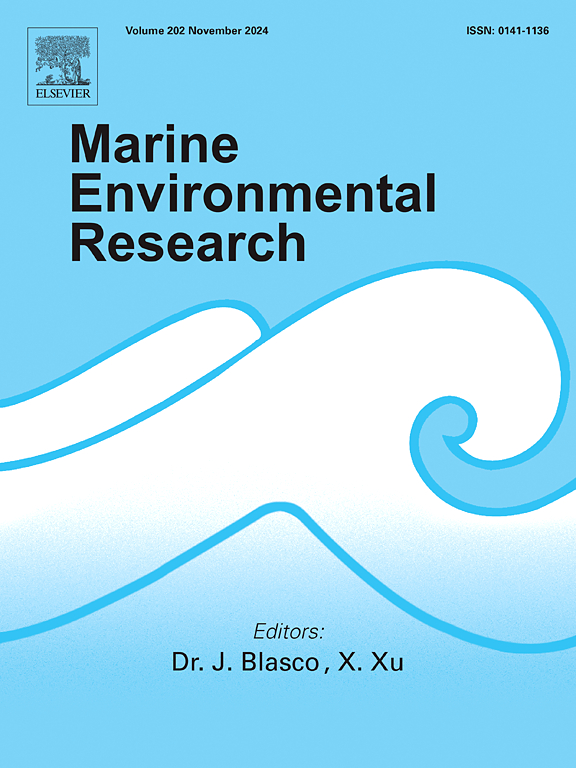Short-term response to light after the polar night in the Arctic kelps Alaria esculenta and Saccharina latissima
IF 3.2
3区 环境科学与生态学
Q2 ENVIRONMENTAL SCIENCES
引用次数: 0
Abstract
The current absence of ice in early spring in a number of Arctic fjords allows sunlight to penetrate the water column about two months earlier than it used to be when a thick ice cover was present. This can potentially change the growth dynamics of permanent seaweed forests. To elucidate the ability of seaweeds to take advantage of this early available light, growth, photosynthetic performance, and biochemical composition has been analyzed in two major forest-forming algal species, Alaria esculenta and Saccharina latissima, from Kongsfjorden (Svalbard) collected in early February, and incubated in dim light and dark conditions. For A. esculenta, new tissue appeared during the last weeks of the polar night, so that the new and old tissues coexisted in the same individuals and were compared. Dim light triggered positive growth rates. The onset of light led to rapid (1 h) increase in the optimum quantum yield (Fv/Fm) in the new tissue of A. esculenta, while the old tissue and S. latissima increased their maximum photosynthetic electron transport rate (ETRm). The new tissue accumulated 3 to 5 times more internal nitrate than the old tissue, but it showed lower content of photosynthetic pigments. Dim light promoted changes in stored carbohydrates in A. esculenta while the total C:N:P ratios remained stable in both species. Furthermore, S. latissima responded to light by decreasing its ∂13C values, indicating some activation of its carbon concentrating mechanism. Overall, dim light showed the potential to trigger photosynthetic metabolism and growth as early as February.
极地夜晚后,北极海带对光线的短期反应
目前,在许多北极峡湾,早春没有冰,这使得阳光穿透水柱的时间比以前厚冰层覆盖的时间提前了大约两个月。这可能会改变永久海藻林的生长动态。为了阐明海藻利用这种早期可用光的能力,我们分析了2月初从斯瓦尔巴群岛的Kongsfjorden收集的两种主要的森林形成藻类Alaria esculenta和Saccharina latissima的生长、光合性能和生化成分,并在昏暗和黑暗的条件下进行了培养。在极夜的最后几个星期里,新组织出现了,因此新组织和旧组织共存于同一个体中并进行了比较。昏暗的灯光触发了正增长率。光照开始后,叶红新组织的最佳量子产率(Fv/Fm)在1 h内迅速增加,而旧组织和叶红的最大光合电子传递率(ETRm)则增加。新组织积累的内部硝酸盐是旧组织的3 ~ 5倍,但光合色素含量较低。昏暗光照促进了沙蚕体内碳水化合物的变化,但两种植物的总碳氮磷比保持稳定。此外,S. latissima通过降低其∂13C值来响应光,表明其碳浓缩机制被激活。总的来说,昏暗的光线早在2月份就显示出了触发光合代谢和生长的潜力。
本文章由计算机程序翻译,如有差异,请以英文原文为准。
求助全文
约1分钟内获得全文
求助全文
来源期刊

Marine environmental research
环境科学-毒理学
CiteScore
5.90
自引率
3.00%
发文量
217
审稿时长
46 days
期刊介绍:
Marine Environmental Research publishes original research papers on chemical, physical, and biological interactions in the oceans and coastal waters. The journal serves as a forum for new information on biology, chemistry, and toxicology and syntheses that advance understanding of marine environmental processes.
Submission of multidisciplinary studies is encouraged. Studies that utilize experimental approaches to clarify the roles of anthropogenic and natural causes of changes in marine ecosystems are especially welcome, as are those studies that represent new developments of a theoretical or conceptual aspect of marine science. All papers published in this journal are reviewed by qualified peers prior to acceptance and publication. Examples of topics considered to be appropriate for the journal include, but are not limited to, the following:
– The extent, persistence, and consequences of change and the recovery from such change in natural marine systems
– The biochemical, physiological, and ecological consequences of contaminants to marine organisms and ecosystems
– The biogeochemistry of naturally occurring and anthropogenic substances
– Models that describe and predict the above processes
– Monitoring studies, to the extent that their results provide new information on functional processes
– Methodological papers describing improved quantitative techniques for the marine sciences.
 求助内容:
求助内容: 应助结果提醒方式:
应助结果提醒方式:


